Tam quan
A Tam quan (chữ Hán: 三關) or Tam môn (chữ Hán: 三門) is a style of traditional gateway symbolic of Vietnamese Buddhism. It has three aisles (traditionally, the middle aisle is the largest and the two side aisles are smaller). Not only are they applied in Buddhist works, they are also commonly applied to other religious works such as Confucianism, Taoism, Vietnamese folk religion and Christianity. They are also applied to non-religious modern buildings such as schools and People's committee buildings.
| Tam quan | |
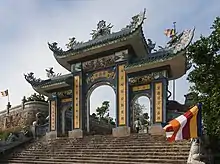 Tam quan of Linh Ứng - Bãi Bụt Temple, Da Nang | |
| Vietnamese alphabet | Tam quan |
|---|---|
| Chữ Hán | 三關 |
.jpg.webp)
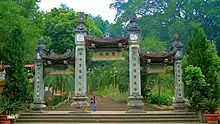
Origin and meaning
The Tam quan carries the concept of "three ways of seeing" of Buddhism, including "hữu quan, 有觀)", "không quan, 空觀)" and "trung quan, 中觀)",[1][2] representing the form (false), the void (anitya) and the middle of both.[3] The second explanation is that the three gates are the gates of the Three Jewels.[4] Another theory holds that the three gates are the "Samadhi" of the Zen sect. Therefore, countries that do not belong to Zen Buddhism do not have Tam quan as the entrance to the temple.
Tam quan gateways derive from Buddhist temple architecture that was transmitted from India to Vietnam via China.[5]
Architecture
Tam quan is mainly three gateways with the middle door usually larger than the two side doors. The wall of the gateway can be wooden or be made up of stone or brick. Above the gateway lays a tiled roof. The two sides of the path are often decorated with couplets, the front of the door is written with the name of the temple or the name of the gateway.
The common form of the gate
The regular form of the gate has three gateways and is also the most common type. Typically Buddhist couplets in Hán văn (Literary Chinese) line the centre doorway. With the name of the place or the gate on a placard on the top of the centre gate.
Multiple floor gate
Small gateways only make one floor, but when built on a larger scale, many places build two roofs or build upper floors. Brick and stone gates almost always have an upper level, although it may just be a fake upper floor to increase the gate's height. There are places built into three floors. When designing the upper floor, there is a pagoda that uses it to hang the bells, the plaques, and the drums used in temple rituals...
Four pillar gate
Tam quan style of four Trụ biểu instead of building walls, uses four pillars, the middle two pillars are higher than the two side pillars to divide into three paths. Above, connecting the four Trụ biểu is a stylized beam to make the gate's centre.
The gateway of Láng Temple is characterized by a four Trụ biểu structure with a curved roof, giving the temple's Tam quan a unique and unique shape in the traditional architecture of Vietnam.[6]
Some popular variations
Variations of the Tam quan are found in some pagodas built into five aisles such as in the case of Sét temple, Hanoi.
Application in non-religious works
Tam quan is applied to many non-religious public works in Vietnam.
Village gate
Traditional Vietnamese village gates usually have only one path (although there are also some places built in the form of a Tam quan), but many places today will build a village gate in the form of a Tam quan to use as a kind of welcome gate.
Gallery
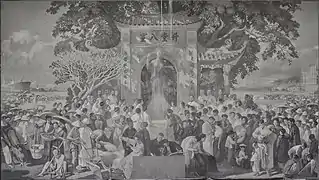 Tam quan in decorative painting at Indochina University lecture hall, Hanoi
Tam quan in decorative painting at Indochina University lecture hall, Hanoi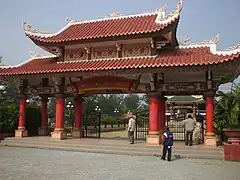 Tam quan at Tomb of Nguyễn Đình Chiểu
Tam quan at Tomb of Nguyễn Đình Chiểu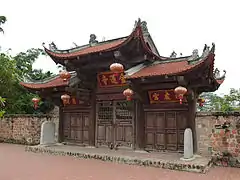 Tam quan of Kim Liên Temple, Hanoi
Tam quan of Kim Liên Temple, Hanoi.jpg.webp) Tam quan of a temple next to the river
Tam quan of a temple next to the river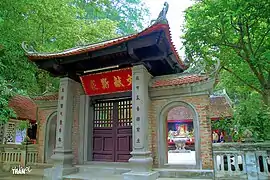 Tam quan of Thượng Temple
Tam quan of Thượng Temple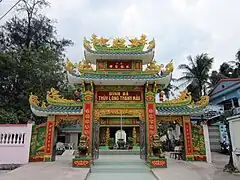 Tam quan of Thủy Long Thánh Mẫu Temple
Tam quan of Thủy Long Thánh Mẫu Temple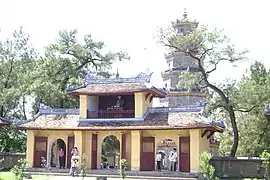 Tam quan of Thiên Mụ Temple built guardhouse above the middle entrance, Huế royal style
Tam quan of Thiên Mụ Temple built guardhouse above the middle entrance, Huế royal style_(24).jpg.webp) Tam quan of Huệ Nghiêm Temple
Tam quan of Huệ Nghiêm Temple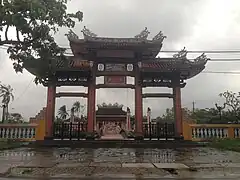 Tam quan at a temple in Hội An
Tam quan at a temple in Hội An.JPG.webp) Tam quan of Tây An Cổ Tự, An Giang
Tam quan of Tây An Cổ Tự, An Giang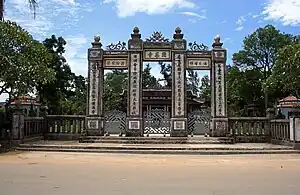 Tam quan style of four pillars Quốc Ân Temple, Huế
Tam quan style of four pillars Quốc Ân Temple, Huế The Tam quan of Láng Temple, Hanoi is a four-pillar style combined with a curved roof
The Tam quan of Láng Temple, Hanoi is a four-pillar style combined with a curved roof Tam quan of Nghiêm Quang temple, Thận Trai village, Bắc Ninh
Tam quan of Nghiêm Quang temple, Thận Trai village, Bắc Ninh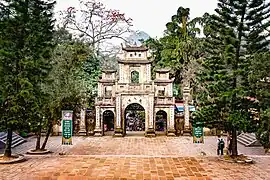 Tam quan Hương Temple, the type with the upper floor
Tam quan Hương Temple, the type with the upper floor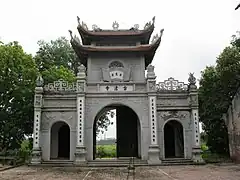 Tam quan Dận Temple, the type with the upper floor
Tam quan Dận Temple, the type with the upper floor A school gate built in the form of a Tam quan
A school gate built in the form of a Tam quan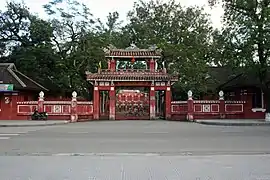
 Gate of Cẩm Phả High School
Gate of Cẩm Phả High School Việt Đức school gate
Việt Đức school gate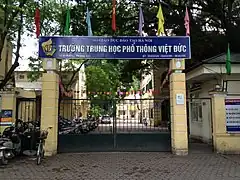 Gate of Việt Đức High School, Lý Thường Kiệt, Hanoi
Gate of Việt Đức High School, Lý Thường Kiệt, Hanoi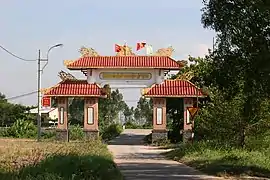 Thanh Lương village gate
Thanh Lương village gate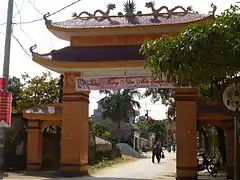 Ngọc Trà village gate, Quảng Trung commune, Quảng Xương, Thanh Hóa, Vietnam
Ngọc Trà village gate, Quảng Trung commune, Quảng Xương, Thanh Hóa, Vietnam Chu Đậu ancient pottery village gate
Chu Đậu ancient pottery village gate Đông Thái village gate
Đông Thái village gate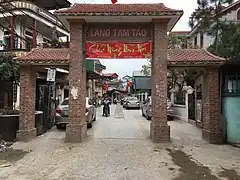 Tam Tảo village gate
Tam Tảo village gate.jpg.webp) Trinh Nữ village gate, Ninh Bình
Trinh Nữ village gate, Ninh Bình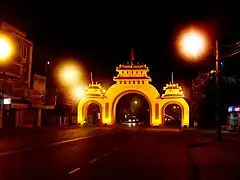 Welcome gate in the form of Tam quan in Rạch Giá city
Welcome gate in the form of Tam quan in Rạch Giá city.jpg.webp) Welcome gate in Mai Xá village
Welcome gate in Mai Xá village
See also
References
- "Tam quan là gì? Ngũ quan là gì? Tất cả những ý nghĩa của tam quan, ngũ quan". Meta.vn.
- Trong họ ngoài làng. Mũi Cà Mau. 1993. p. 102-103.
- "Cổng Tam quan". Danang newspaper.
- "Ý nghĩa Cổng Tam Quan trong văn hóa Việt". Ngotoc.vn.
- Phạm, Tuấn. "Tam quan trong kiến trúc chùa Việt Nam". Hannom.org.
- "Sự "lây lan" của Tam quan chùa Láng". Thể thao và Văn hóa.
Sources
- Nguyễn Bá Lăng. Vietnamese Buddhist Architecture Vol. II. Paris: Nguyễn Bá Lăng, 2001.